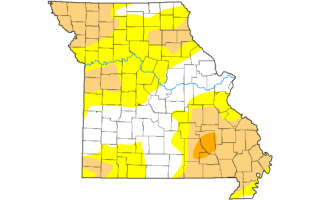Hot, Dry Conditions Lead To Ample Bean Pod Setting

Parts of Missouri missed out on rain last week amid temperatures two degrees above normal, but their soybean plants made strong progress in crop production. The weekly USDA Crop Progress report indicates that 11 percent of plants set pods in the past week, double the five-year average. 35 percent of the crop has bloomed, and 96 percent has emerged. Conditions also improved from a week ago, with 65 percent in good or excellent condition versus five percent poor or very poor. The first three percent of corn has doughed, just ahead of the five-year average. Nearly three-fifths of corn has tasseled, six points below the five-year average. The crop is rated 71 percent good to excellent, two points better than last week, and four percent is listed in poor condition. Winter wheat harvest is 95 percent complete.
Missouri’s cotton crop still has not set bolls, keeping the crop at least two weeks behind the average pace. 31 percent of the crop is squaring, just ahead of a year ago and still half that of the five-year average. However, with areas of the Bootheel receiving beneficial rains, crop conditions continue to recover, with 42 percent of cotton in good shape, versus 20 percent rated poor or very poor. Rice heading is only at three percent, down from the five-year average of 13 percent. 61 percent of rice is in good or excellent condition, against seven percent in poor or very poor shape.
Increasing drought conditions led to a decrease in pasture conditions. 54 percent of fields are good to excellent, and six percent are poor or very poor. Almost three-fourths of alfalfa fields have received their second cutting, and 90 percent of other hay has been cut. Five percent of Missouri farmers reportedly have a shortage of hay supply, compared to nine percent with a surplus. Seven percent are now lacking stock water supply, compared to three percent with a surplus. Soils are drying out, with 40 percent of topsoil and 23 percent of subsoil lacking adequate moisture. Five percent of topsoil and four percent of subsoil have a moisture surplus. An average of six-point-six days were suitable for fieldwork.






